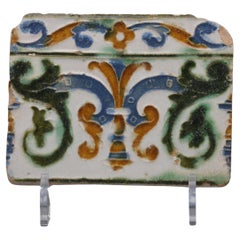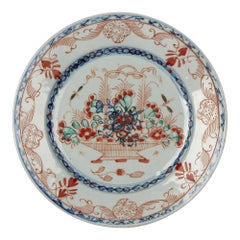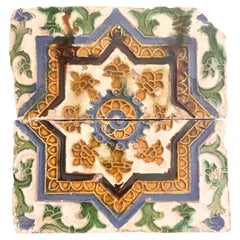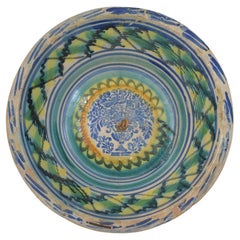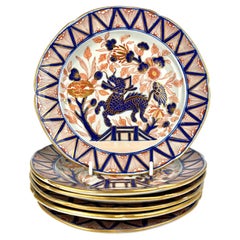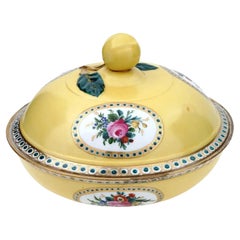18th Century and Earlier Ceramics
to
49
433
433
1,503
6,935
1,813
962
4,185
1,084
119
41
278
360
211
854
1,126
514
179
72
97
24
23
22
4
2
1
1
1
1
428
116
115
48
18
306
112
315
98
94
84
79
433
433
433
21
11
11
9
7
Period: 18th Century and Earlier
Spanish Azulejo Tile Arista y Cuenca - Toledo 16th century
Located in DELFT, NL
Early Arista y cuenca tile made in Toledo. Tile decorated in renaissance with stylized flowers was probably made between 1550 and 1575.
Category
Spanish Renaissance Antique 18th Century and Earlier Ceramics
Materials
Earthenware
Chinese Qianlong Hand Painted Porcelain Plate, 18th Century
Located in Bishop's Stortford, Hertfordshire
An exceptional antique Chinese Qianlong porcelain plate decorated in underglaze blue and overpainted in red and green glazes with light gilding with...
Category
Chinese Antique 18th Century and Earlier Ceramics
Materials
Porcelain
Spanish Azulejo Tiles 'Dos por Tabla' - Arista y Cuenca - Toledo 16th century
Located in DELFT, NL
Set of Spanish tiles of the 'dos por tabla/ type in the Arista y cuenca tile made in Toledo. This particular type was to adorn ceilings.
Tile decorated in renaissance with stylized ...
Category
Spanish Renaissance Antique 18th Century and Earlier Ceramics
Materials
Earthenware
Large 18-19th Century Spanish Glazed Earthenware Bowl
Located in Buisson, FR
Very rare and beautiful Spanish earthenware bowl. Wonderful decoration with a bird sitting on a vase of flowers
Sevilla, Spain, circa 1750-1850
Weathered and amazing antique repair ...
Category
Spanish Rustic Antique 18th Century and Earlier Ceramics
Materials
Earthenware
$956 Sale Price
41% Off
Cabinet Set Six Imari Dessert Plates with Dragons 18th Century Turner's Patent
By John Turner
Located in Katonah, NY
This set of six plates, crafted by John Turner around 1795, features the exquisite Imari color palette of iron red, cobalt blue, and radiant gold. The color combination creates a vib...
Category
English Chinoiserie Antique 18th Century and Earlier Ceramics
Materials
Ironstone
18th Century Meissen Marcolini Candy Bowl For Ottoman Market
Located in Queens, NY
A German Meissen yellow porcelain candy bowl with a figural knob. The exterior of the bowl is delicately adorned with oval shaped medallions with images of bouquets of flowers, geome...
Category
German Antique 18th Century and Earlier Ceramics
Materials
Porcelain
18th Century Newhall Porcelain Coffee Cup Pattern 139, Circa 1790
By New Hall
Located in Lincoln, Lincolnshire
This is a hard paste porcelain coffee cup, by New Hall, dating to the late 18th century George 111rd period, circa 1790.
The piece is well potted on a low foot with a plain loop h...
Category
English Georgian Antique 18th Century and Earlier Ceramics
Materials
Porcelain
Spanish Moorish Mudejar Olambrilla Tile, Cuerda Seca - Toledo 15th/16th century
Located in DELFT, NL
Rare late 15th or early 16th century Mudejar tile of the so-called ‘Arista’ or 'cuerda seca' technique.
The central motif is an eight-pointed star, which in turn encloses smaller on...
Category
Spanish Renaissance Antique 18th Century and Earlier Ceramics
Materials
Earthenware
Early New Hall Porcelain Coffee Can & Saucer Duo Chinese Pattern 421, circa 1800
By New Hall
Located in Lincoln, Lincolnshire
This is a hard paste porcelain coffee can & saucer duo by New Hall, hand decorated with their Chinese figure pattern number 421, dating to the English George 3rd...
Category
English Chinoiserie Antique 18th Century and Earlier Ceramics
Materials
Porcelain
FOUR 17th Century Delft Blue and White Wall Tiles on Frame Set 2, Netherlands
Located in Lincoln, Lincolnshire
These are Four Delft ceramic wall tiles mounted on a modern wood frame, all with a blue and white hand painted flower pattern, made in the Netherlands during the 17th century, circa ...
Category
Dutch Dutch Colonial Antique 18th Century and Earlier Ceramics
Materials
Earthenware
Chinese Stoneware Bowl or Dish Longquan Celadon Incised, Yuan Dynasty 1271-1368
Located in Lincoln, Lincolnshire
This is a very old interesting Chinese stoneware Longquan Celadon bowl or plate with incised decoration, which we date to the Yuan Dynasty, circa 1300.
The bowl is well potted on a low foot.
The bowl is an olive green colour having a celadon glaze with incised decoration to its centre of what looks like a flower stem and additionally three incised string lines to the outer wall. Unglazed parts fire to a terracotta brown colour as with the base section
The piece is unmarked but for similar pieces see the superb book: Chinese Ceramics by He Li published by Thames & Hudson, 1996; pages 164 to 184.
NOTES
Longquan is a city in South west China. These wares were produced over a long time period from 959 to 1550; which covers the Northern Song, Southern Song...
Category
Chinese Other Antique 18th Century and Earlier Ceramics
Materials
Stoneware
Rare Meissen Marcolini Porcelain Chinoiserie Incense Burner Vase and Cover
Located in Queens, NY
A rare Meissen Marcolini Porcelain Chinoiserie incense burner vase and cover, made for the Chinese market, circa 1800, blue cross swords and star mark, Pressnummer 58
A Museum Quality Piece.
Painted in the sought after famille rose palette with sprigs of indianische Blumen and enriched in gilding, the simulated pierced body supported by four feet painted with stylized dragons, the pierced cover with a Buddhist lion finial.
10" high x 6" wide x 6" deep
The shape of this piece, which appears to be unrecorded in the literature, is inspired by similar Chinese porcelain censers from the Qing Dynasty, Kangxi Period (1654-1722). An example in the Palace Museum, Beijing, is illustrated by Li Yi-hua in Qing Porcelain of Kangxi, Yongzheng and Qianlong Periods from the Palace Museum Collection, Hong Kong, 1989, pl. 65. Another in the British Museum, London (museum no. PDF, A.812) is catalogued as a perfume-holder.
These porcelain examples are in turn inspired by ancient Chinese bronzes from both the Shang (1600-1046 BC) and the Zhou (1046-246 BCE) dynasties, an example of which was sold anonymously by Christie's New York, 22 March 2019, lot 1601. This chain of inspiration tracking backwards from the 19th century to antiquity provides a clear example of how ceramics, and indeed other mediums, are able to influence and motivate the works of later generations.
For a Meissen porcelain snuff...
Category
German Chinoiserie Antique 18th Century and Earlier Ceramics
Materials
Porcelain
$27,500 Sale Price
44% Off
Spanish Azulejo Tile Arista y Cuenca - Toledo 16th century
Located in DELFT, NL
Early Arista y cuenca tile made in Toledo. Tile decorated in renaissance with stylized flowers was probably made between 1550 and 1575.
Category
Spanish Renaissance Antique 18th Century and Earlier Ceramics
Materials
Earthenware
Ceramic Traditional Hand Painted Plate by Catalan Artist Diaz Costa, circa 1960
Located in Barcelona, ES
Immerse yourself in the artistic legacy of Catalan artist Diaz Costa with our vintage hand-painted ceramic plate artwork, circa 1960. This exquisite piece captures the essence of mid...
Category
Spanish Antique 18th Century and Earlier Ceramics
Materials
Ceramic
$1,760 Sale Price
25% Off
19th Century Italian Majolica Dish with Renaissance Figures
Located in San Francisco, CA
19th century Italian Majolica dish with Renaissance figures
Superb highly decorated Italian Majolica plate with hand a hand painted scene of Roman mythology; The abduction of Sabine...
Category
Italian Antique 18th Century and Earlier Ceramics
Materials
Ceramic
Spanish Azulejo Tile Arista y Cuenca - Toledo 16th century
Located in DELFT, NL
Early Arista y Cuenca tile made in Toledo. Azulejo Toledano. Alhambra tile decorated in renaissance mudejar style geometrical design.
Probably made between 1550 and 1575.
In very g...
Category
Spanish Renaissance Antique 18th Century and Earlier Ceramics
Materials
Earthenware, Maiolica
Spanish Azulejo Tile Arista y Cuenca - Toledo 16th century
Located in DELFT, NL
Early Arista y Cuenca tile made in Toledo. Azulejo Toledano. Alhambra tile decorated in renaissance mudejar style geometrical design.
Probably made between 1550 and 1575.
In very g...
Category
Spanish Renaissance Antique 18th Century and Earlier Ceramics
Materials
Earthenware, Maiolica
Spanish Azulejo Tile Arista y Cuenca - Toledo 16th century
Located in DELFT, NL
Early Arista y cuenca tile made in Toledo. Tile decorated in renaissance with stylized flowers was probably made between 1550 and 1575.
Category
Spanish Renaissance Antique 18th Century and Earlier Ceramics
Materials
Earthenware
Italian Renaissance Plate, Patanazzi Workshop Urbino, End of 16th Century
Located in Milano, IT
Acquareccia plate
Patanazzi workshop
Urbino, last quarter of the 16th century
It measures diameter 17.12 in; foot diameter 11.53 in; height 1.88 in (43.5 cm; 29.3 cm; 4.8 cm).
Weight
State of conservation: wear and a few small minimal detachments of enamel, chipping on the raised areas, peeling of enamel at the brim on the back.
This large, shallow basin is equipped with a wide and convex well. It is umbonate with a contoured center. The brim, short and flat, is enclosed in a double rounded and barely raised edge. The basin has a flat base without rims; it has a slightly concave center in correspondence to the well.
The shape takes inspiration from the basins associated with the metal forged amphora pourers that traditionally adorned the credenza. These were used from the Middle Ages to wash hands during banquets. Two or three people washed their hands in the same basin and it was considered an honor to wash one’s hands with an illustrious person.
The decoration is arranged in concentric bands with, in the center of the umbo, an unidentified shield on a blue background: an oval banded in gold with a blue head, a gold star and a field with a burning pitcher.
Rings of faux pods separate the center from a series of grotesque motifs of small birds and masks. These go around the basin and are, in fact, faithfully repeated on the brim. The main decoration develops inside the flounce of the basin, which sees alternating symmetrical figures of winged harpies and chimeras. The ornamentation, outlined in orange, green and blue, stands out against the white enamel background.
This decorative style, defined since the Renaissance as “grottesche” or “raffaellesche”, refers to the decorations introduced after the discovery of the paintings of the Domus Aurea towards the end of the fifteenth century. The discovery of Nero's palace, buried inside Colle Oppio by damnatio memoriae, occurred by chance when a young Roman, in 1480, fell into a large crack which had opened in the ground on the hill, thus finding himself in a cave with walls covered with painted figures.
The great artists present in the papal city, including Pinturicchio, Ghirlandaio, Raffaello, immediately visited these caves. The decorations found there soon became a decorative subject of immense success: the term grotesque , with the meaning of “unusual,” “caricatured,” or “monstrous,” was later commented by Vasari in 1550 as “una spezie di pittura licenziose e ridicole molto”( “a very licentious and ridiculous kind of painting”).
The decorations “a grottesche” also widely circulated in ceramic factories, through the use of engravings, variously interpreted according to the creativity of the artists or the requests of the client.
Our basin is reflected in similar artifacts produced at the end of the sixteenth century by the factories of the Urbino district. See the series of basins preserved in the main French museums, among which the closest in morphology is that of the Campana collection of the Louvre (Inv. OA1496); this however has a more complex figure decoration, while the decoration of our specimen is sober and with a watercolor style.
The style, sure in its execution, approaches decorative results still close to the works produced around the middle of the sixteenth century by the Fontana workshop. The decoration is closely linked to their taste, which later finds its natural outlet, through the work of Antonio, also in the Patanazzi workshop. Studies show the contiguity between the two workshops due to the kinship and collaboration between the masters Orazio Fontana and Antonio Patanazzi, both trained in the workshop of Guido Fontana il Durantino. It is therefore almost natural that their works, often created according to similar typologies and under the aegis of the same commissions, are not always easily distinguishable, so much so that the presence of historiated or “grottesche” works by Orazio is documented and preserved in Antonio Patanazzi's workshop. Given that the studies have always emphasized the collaboration between several hands in the context of the shops, it is known that the most ancient “grottesche” works thus far known, can be dated from 1560, when the Fontana shop created the so-called Servizio Spagnolo (Spanish Service) and how, from that moment on, this ornamentation became one of the most requested by high-ranking clients. We remember the works created for the Granduchi di Toscana, when Flaminio Fontana along with his uncle Orazio supplied ceramics to Florence, and, later, other commissions of considerable importance: those for the service of the Duchi d’Este or for the Messina Farmacia of Roccavaldina, associated with the Patanazzi workshop when, now after 1580, Antonio Patanazzi began to sign his own work.
Thus, in our basin, the presence of masks hanging from garlands, a theme of more ancient memory, is associated in the work with more advanced stylistic motifs, such as the hatching of the chimeras and harpies. These are found here on the front with the wings painted in two ornate ways. In addition, the theme of the birds on the edge completes the decoration along the thin brim and can be seen as representing an early style typical of the Urbino district during a period of activity and collaboration between the two workshops. Later, a more “doll-like” decorative choice, typical of the end of the century and the beginning of the seventeenth century, characterized the period of the Patanazzi workshop under the direction of Francesco.
Bibliography:
Philippe Morel, Il funzionamento simbolico e la critica delle grottesche nella seconda metà del Cinquecento, in: Marcello Fagiolo, (a cura di), Roma e...
Category
Italian Renaissance Antique 18th Century and Earlier Ceramics
Materials
Maiolica
Antique Ceramic Golf Tile
Located in Oxfordshire, GB
Dutch Delft Kolf Tile.
An early Dutch delft blue and white golf tile - hand painted with a Kolf scene depicting a Colf/ Kolf player. The blue image is on an off white background with...
Category
Dutch Sporting Art Antique 18th Century and Earlier Ceramics
Materials
Ceramic
18th Century Spanish or North African Faience Deep Bowl
Located in Chapel Hill, NC
A stunning Spanish or North African faience deep bowl. 18th century. Well cared for with various old rim repairs typical of the form. Red ware base. 15 1/4" diameter, 4" height.
We ...
Category
Antique 18th Century and Earlier Ceramics
Materials
Ceramic
$695 Sale Price
42% Off
Chinese Large Dish or Plate 11+ins dia Porcelain Blue & White, Yongzheng Ca 1730
Located in Lincoln, Lincolnshire
This is a beautifully hand-painted Chinese Export porcelain blue and white, large deep plate or dish which we date to the Qing, early 18th Century, Yongzheng period, Circa 1730.
The...
Category
Chinese Qing Antique 18th Century and Earlier Ceramics
Materials
Porcelain
Kangxi Period Chinese Plate Porcelain Blue & White Chenghua Mark, Circa 1680
Located in Lincoln, Lincolnshire
This is a very beautifully hand painted Chinese porcelain blue and white Dish or Plate from the Qing, Kangxi period ( 1662-1722), dating to Circa 1680 or slightly earlier
This is a well potted dish with 16 lobes or ribs, a wavy barbed rim, a very well cut foot rim and a very white glaze.
The plate is very finely hand painted in a free flowing style, characteristic of the period, in varying shades of a clear cobalt blue, from the very dark to the very light blue.
The central well is hand decorated with an iconic outdoor...
Category
Chinese Qing Antique 18th Century and Earlier Ceramics
Materials
Porcelain
Savona Italian Tin Glazed Polychrome Painted Pottery Syrup Jar
Located in Bishop's Stortford, Hertfordshire
An antique Italian hand painted Savona tin glazed syrup jar inscribed AQUA DE PIANTAGNE dating from the early 18th century, the rounded earthenware jar stand...
Category
Italian Baroque Antique 18th Century and Earlier Ceramics
Materials
Pottery
Chinese Kangxi mark & period Very Large Imari Dish or Plate Porcelain, Ca 1710
Located in Lincoln, Lincolnshire
This is a very beautifully hand painted Chinese Imari porcelain very large Dish or Plate / Platter from the Qing, Kangxi period, 1662-1722, dating to Circa 1710.
Very large diameter...
Category
Chinese Qing Antique 18th Century and Earlier Ceramics
Materials
Porcelain
Japanese Ao-Oribe Glazed Stoneware Dish, Early Edo Period, 17th Century, Japan
Located in Austin, TX
A fine and rare Japanese ao-oribe glazed minoyaki stoneware dish, late Momoyama or early Edo period, 17th century, Japan.
The circular dish of wheel thrown ...
Category
Japanese Edo Antique 18th Century and Earlier Ceramics
Materials
Stoneware
Large Chinese Export Punch Bowl, Painted & Gilt Decoration in Mandarin Palette
Located in Atlanta, GA
Large & Very Fine Chinese Export Punch Bowl, with Painted & Gilt decoration in the Mandarin palette. Jingdezhen region, China ca. 1780.
Category
Chinese Chinese Export Antique 18th Century and Earlier Ceramics
Materials
Porcelain
Early 17th Century Ottoman Empire Iznik Pottery Dish
Located in Fort Lauderdale, FL
An Iznik pottery dish made in the first half of the 17th century and decorated with chrysanthemums and tulips. The rim features the rock and wave pattern.
Under the direction of O...
Category
Turkish Islamic Antique 18th Century and Earlier Ceramics
Materials
Ceramic
Spanish Moorish Mudejar Tile, Arista y Cuenca - Sevilla 16th century
Located in DELFT, NL
Rare late 15th or early 16th century Mudejar tile of the so-called ‘Arista’ technique with intricate geometric decoration.
Good condition; some chipping to the edges, some wear to ...
Category
Spanish Renaissance Antique 18th Century and Earlier Ceramics
Materials
Earthenware, Clay, Maiolica
NINE antique Delft Wall Tiles Blue & White scenes, Netherlands mainly 18th C
Located in Lincoln, Lincolnshire
These are NINE Delft ceramic wall tiles, all with different blue and white hand painted patterns, made in the Netherlands, from the 19th Century to the 17th Century, but mainly 18th Century.
Each tile is nominally slightly over 5 inches square..
All nine tiles are unique, being individually hand painted with different scenes and patterns featuring various scenes with buildings, trees, watersides, boats and one floral, with most having spider motif corners. They are all enamelled in cobalt blue, using different shades of blue, which varies slightly from tile to tile as expected:- please see the images.
Two of the tiles have scenes within double blue circles.
NOTES:
The central floral pattern tile is slightly thicker and dates to the 17th C
Seven Tiles are 18th Century and one is 19th Century ( blue tinged glaze)
Overall a beautiful set of individual hand painted antique Delft tiles...
Category
Dutch Dutch Colonial Antique 18th Century and Earlier Ceramics
Materials
Earthenware
Kangxi Famille Verte Porcelain Large Dish, Qing Dynasty, 17th/18th c
Located in Austin, TX
A large and magnificent Chinese famille verte enameled porcelain large dish or charger, Qing Dynasty, Kangxi Period (1662 - 1722), circa 1700, China.
The shallow, shaped dish of fo...
Category
Chinese Qing Antique 18th Century and Earlier Ceramics
Materials
Enamel
Spanish Azulejo Tile Arista y Cuenca - Toledo 16th century
Located in DELFT, NL
Early Arista y cuenca tiles made in Toledo. Tile decorated in renaissance with stylized flowers, probably made between 1550 and 1575.
I have four of them available, please reach o...
Category
Spanish Renaissance Antique 18th Century and Earlier Ceramics
Materials
Earthenware, Maiolica
18th Century Portuguese "Azulejos" The Virgen"
Located in Madrid, ES
Largest collection of Portuguese tiles in the world
18th century Portuguese " Angels "
Measures: 364 cm x 252 cm
439 tiles
Important note: This panel is with the tiles restored 18...
Category
Portuguese Baroque Antique 18th Century and Earlier Ceramics
Materials
Ceramic
18th Century Portuguese "Azulejos" Panel "River Scene"
Located in Madrid, ES
Largest collection of Portuguese tiles in the world
18th century Portuguese " Azulejos " River Scene"
Measures: 181cm x 087cm
78 tiles
Important note: This panel is with the tiles...
Category
Portuguese Baroque Antique 18th Century and Earlier Ceramics
Materials
Ceramic
Pair of 18th Century Chinese & Meissen Famille Verte Porcelain Plates
Located in Fort Lauderdale, FL
A pair of famille verte porcelain plates, the left made in China during the Kangxi period (r. 1662–1722) and the right a copy by Meissen made circa 1740.
Chinese porcelain has alw...
Category
Chinese Chinese Export Antique 18th Century and Earlier Ceramics
Materials
Porcelain
Spanish Azulejo Tile Arista y Cuenca - Toledo 16th century
Located in DELFT, NL
Early Arista y cuenca tile made in Toledo. Tile decorated in renaissance with stylized flowers was probably made between 1550 and 1575.
Category
Spanish Renaissance Antique 18th Century and Earlier Ceramics
Materials
Earthenware
Chinese Kraak period Plate or Dish Porcelain Blue and White, Ming Wanli, Ca 1610
Located in Lincoln, Lincolnshire
This is a hand-painted Chinese Export Kraak porcelain blue and white Side Plate or Dish, which we date to the Ming, Wanli period,( 1573-1620 ), datin...
Category
Chinese Chinese Export Antique 18th Century and Earlier Ceramics
Materials
Porcelain
Chinese Kraak Period Plate or Dish-B Porcelain Blue & White, Ming Wanli Ca 1610
Located in Lincoln, Lincolnshire
This is a hand-painted Chinese Export Kraak porcelain blue and white Side Plate or Dish, which we date to the Ming, Wanli period,( 1573-1620 ), datin...
Category
Chinese Chinese Export Antique 18th Century and Earlier Ceramics
Materials
Porcelain
Early Wedgwood Dipped Pearlware Bough Pot
By Wedgwood
Located in Fort Lauderdale, FL
A dark brown-glazed pearlware bough pot with pierced cover and applied decoration, made by Wedgwood circa 1785.
The development of a whiteware body had been a goal of ceramicists ac...
Category
British Neoclassical Antique 18th Century and Earlier Ceramics
Materials
Ceramic, Earthenware, Pearlware
18th Century Portuguese " Azulejos " Saint Antony"
Located in Madrid, ES
Largest collection of Portuguese tiles in the world
18th Century Portuguese "Saint Antony"
Measures: 252 cm x 294 cm
Important note: This panel is with the tiles restored 18th ce...
Category
Portuguese Baroque Antique 18th Century and Earlier Ceramics
Materials
Ceramic
DINNER SET Antique Chinese Porcelain 18C Kangxi/Yongzheng Period Blue White
Located in Amsterdam, Noord Holland
Sharing with you this fantastic and large dinner set. It consists of several dishes of various size, 3 tureens, two underplatters and two salt cellars.
All painted with a high qualit...
Category
Chinese Qing Antique 18th Century and Earlier Ceramics
Materials
Porcelain
$8,510 Sale Price
20% Off
Spanish Azulejo Arabe / Mudejar Tile - Arista y Cuenca - 15th century
Located in DELFT, NL
Early Arabe / Mudejar style tile with geometric decoration, made late 15th century.
Category
Spanish Renaissance Antique 18th Century and Earlier Ceramics
Materials
Earthenware
18th Century Chinese Blue and White Large Plate, Qing Qianlong circa 1750
Located in Lincoln, Lincolnshire
This is a very good Chinese porcelain large plate, made for the export (Canton) market, during the middle of the 18th century, Qing-Qianl...
Category
Chinese Qing Antique 18th Century and Earlier Ceramics
Materials
Porcelain
Glazed ceramic spice rack. Talavera de la Reina, 18th century.
Located in Madrid, ES
Glazed ceramic spice rack. Talavera de la Reina, 18th century.
Spice rack with three wells in the shape of an equilateral triangle, made of ceramic and decorated with high-temperatu...
Category
Spanish Neoclassical Revival Antique 18th Century and Earlier Ceramics
Materials
Ceramic
Chinese Export Porcelain Oval Famille Rose Dish
Located in Downingtown, PA
The Chinese Export porcelain dish in the famille rose palette is painted on the border with meandering vines and flowers which surrounds a central panel decorated with vases and pots of flowers...
Category
Chinese Chinese Export Antique 18th Century and Earlier Ceramics
Materials
Porcelain
Chinese Imari Porcelain Plate or Bowl Qing Kangxi Mark & period, Ca 1700
Located in Lincoln, Lincolnshire
This is a beautifully hand painted Chinese Export porcelain Plate or Bowl from the Qing, Kangxi period, 1662-1722, fully marked to the base with the Kang...
Category
Chinese Chinese Export Antique 18th Century and Earlier Ceramics
Materials
Porcelain
Pair Antique 17th Century Spanish Blue & White Pottery Albarelli Drug Jars 1680
Located in Portland, OR
A very good pair of antique 17th century Spanish blue & white pottery albarelli or apothecary jars, circa 1680.
From the 15th century onward cylindrical drug jars like this were used...
Category
Spanish Baroque Antique 18th Century and Earlier Ceramics
Materials
Pottery
18th Century Wedgwood & John Flaxman, Blue Jasperware "Dancing Hours" Plaque
Located in West Palm Beach, FL
18th Century Wedgwood & John Flaxman, Blue Jasperware "Dancing Hours" Plaque, England, circa 1790
This exquisite late 18th-century Wedgwood blue jasperware plaque from the "Dancing ...
Category
Antique 18th Century and Earlier Ceramics
Materials
Ceramic, Giltwood
$1,036 Sale Price
20% Off
18th C Chinese Porcelain Plate Blue & White Hand Painted, Qing Qianlong Ca 1770
Located in Lincoln, Lincolnshire
This is a hand painted blue and white Chinese porcelain plate, dating to the second half of the 18th century, circa 1770, the Qing Qianlong dynasty.
This very good condition of this...
Category
Chinese Chinese Export Antique 18th Century and Earlier Ceramics
Materials
Porcelain
18th Century, Chinese Export Coral and Puce Porcelain Tea Service
Located in Downingtown, PA
Chinese export porcelain service spectacularly decorated with a smart coral scale ground with panels of puce flowers.
The service com...
Category
Chinese Chinese Export Antique 18th Century and Earlier Ceramics
Materials
Porcelain
Chinese Porcelain Plate or Bowl Qing Kangxi Mark and Period, Ca 1700
Located in Lincoln, Lincolnshire
This is a beautifully hand painted Chinese Export porcelain Plate or Bowl from the Qing, Kangxi period, 1662-1722, fully marked to the base with the Kang...
Category
Chinese Chinese Export Antique 18th Century and Earlier Ceramics
Materials
Porcelain
Wonderful Large Tuscan Round Plate (Siena) from the 18th Century
By Europa
Located in Madrid, ES
Wonderful Large Tuscan Round Plate (Siena) from the 18th Century
decorated with a battle scene.
Marked Siena with the date 1527 on the wing.
Italian majolica. .
Diameter: 45 cm.
good...
Category
Italian Rococo Antique 18th Century and Earlier Ceramics
Materials
Majolica
Early 20th Century Chinese Porcelain Bucket Vase, Famille Verte
Located in Vigonza, Padua
Beautiful big bucket vase with two steel handles, Famille verte. Excellent decorated with women and young boys in a walled garden and princess on horseback...
Category
Chinese Chinese Chippendale Antique 18th Century and Earlier Ceramics
Materials
Ceramic, Porcelain
Spanish Azulejo Tile Arista y Cuenca - Toledo 16th century
Located in DELFT, NL
Early Arista y cuenca tile fragment made in Toledo. Tile decorated in renaissance with stylized flowers was probably made between 1550 and 1575.
Losses and wear.
Category
Spanish Renaissance Antique 18th Century and Earlier Ceramics
Materials
Earthenware
French, 18th Century Glazed Earthenware Rouen Platter
Located in Buisson, FR
Rare Rouen plate with beautiful blue decoration.
France, circa 1750
Good condition.
Category
French French Provincial Antique 18th Century and Earlier Ceramics
Materials
Earthenware
$391 Sale Price
53% Off
Heraldic Spanish Azulejo Tile - Arista y Cuenca - Sevilla, early 16th century
Located in DELFT, NL
Important heraldic Spanish tile of the 'azulejo por tabla para techo' type, in arista y cuenca technique, made in Sevilla in the early 16th century.
Depicting a two-section tower an...
Category
Spanish Renaissance Antique 18th Century and Earlier Ceramics
Materials
Earthenware
Italian Maiolica Ancient Sugar Bowl, Lodi, 1770-1780
Located in Milano, IT
Maiolica sugar bowl
Antonio Ferretti Manufacture
Lodi, Circa 1770-1780
Maiolica polychrome decorated “a piccolo fuoco” (third fire).
It measures 3.54 x 4.52 x 3.54 in (9 x 11,5 x 9 cm)
Weight: 0.394 lb (0.179 kg)
State of conservation: small and slight chips on the edges.
The small sugar bowl has a swollen and ribbed body resting on a flat base. The cap-shaped lid follows the rib of the container and is topped with a small knob in the shape of a two-colored fruit.
The sugar bowl is painted “a piccolo fuoco” (third fire) with the characteristic floral motif of bunches and isolated semis.
An example which closely corresponds to this one is kept at the Civic Museum in Lodi (G. Gregorietti, Maioliche di Lodi, Milano e Pavia, Catalogo della Mostra, Milano, 1964 n. 137).
This decorative style represented a strong point of the Lodi factory, which established itself thanks to the vivid nature of the colors made possible by the introduction of a new technique perfected by Paul Hannong in Strasbourg and later introduced by Antonio Ferretti to Italy. The production process, called “piccolo fuoco” (third fire), allowed the use of a greater number of colors than in the past; in particular, the purple of Cassius, a red made from gold chloride, was introduced. Its use allowed for many more tones and shades, from pink to purple.
The Ferretti family started their maiolica manufacturing business in Lodi in 1725.
The forefather Simpliciano started the business by purchasing an ancient furnace in 1725 and, indeed, we have evidence of the full activity of the furnaces starting from April of the same year (Novasconi-Ferrari-Corvi, 1964, p. 26 n. 4). Simpliciano started a production of excellence also thanks to the ownership of clay quarries in Stradella, not far from Pavia. The production was so successful that in 1726 a decree of the Turin Chamber came to prohibit the importation of foreign ceramics, especially from Lodi, to protect internal production (G. Lise, La ceramica a Lodi, Lodi 1981, p. 59).
In its initial stages, the manufacture produced maolicas painted with the “a gran fuoco” (double fire) technique, often in turquoise monochrome, with ornamentation derived from compositional modules in vogue in Rouen in France. This was also thanks to the collaboration of painters like Giorgio Giacinto Rossetti, who placed his name on the best specimens next to the initials of the factory.
In 1748 Simpliciano made his will (Gelmini, 1995, p. 30) appointing his son Giuseppe Antonio (known as Antonio) as universal heir. After 1750, when Simpliciano passed away, Antonio was directly involved in the maiolica factory, increasing its fortunes and achieving a reputation on a European level. Particularly important was the aforementioned introduction in 1760 of the innovative “a piccolo fuoco” (third fire) processing, which, expanding the ornamental repertoire with Saxon-inspired floral themes, was able to commercially compete with the German porcelains that had one of its most renowned offerings in the naturalistic Deutsche Blumen. Antonio Ferretti understood and promoted this technique and this decoration, proposing it in a fresher and more corrective version, less linked to botanical tables, both with or without contour lines, as well as in purple or green monochrome. After efforts to introduce more industrial production techniques to the sector succeeded, even the Ferretti manufacture, in the last decade of the eighteenth century, started heading towards decline despite its attempts to adapt production to neoclassical tastes.
In 1796 the Napoleonic battle for the conquest of the Lodi bridge over the Adda definitively compromised the furnaces. Production resumed, albeit in a rather stunted manner, until Antonio's death on 29 December 1810. (M. L. Gelmini, pp. 28-30, 38, 43 sgg., 130-136 (for Simpliciano); pp. 31 sgg., 45-47, 142-192 (for Antonio).
Bibliography
G. Gregorietti, Maioliche di Lodi Milano e Pavia Catalogo della Mostra, Milano, 1964 n. 137;
C. Baroni, Storia delle ceramiche nel Lodigiano, in Archivio storico per la città e i comuni del circondario e della diocesi di Lodi, XXXIV (1915), pp. 118, 124, 142; XXXV (1916), pp. 5-8;
C. Baroni, La maiolica antica di Lodi, in Archivio storico lombardo, LVIII (1931), pp. 453-455;
L. Ciboldi, La maiolica lodigiana, in Archivio storico lodigiano, LXXX (1953), pp. 25 sgg.;
S. Levy, Maioliche settecentesche lombarde e venete, Milano 1962, pp. 17 sgg.;
A. Novasconi - S. Ferrari - S. Corvi, La ceramica lodigiana, Lodi 1964, ad Indicem; Maioliche di Lodi, Milano e Pavia (catal.), Milano 1964, p. 17;
O. Ferrari - G. Scavizzi, Maioliche italiane del Seicento e del Settecento, Milano 1965, pp. 26 sgg.;
G. C. Sciolla, Lodi. Museo civico, Bologna 1977, pp. 69-85 passim; G. Lise, La ceramica a Lodi, Lodi 1981;
M. Vitali, in Storia dell'arte ceramica...
Category
Italian Rococo Antique 18th Century and Earlier Ceramics
Materials
Maiolica
Ancient Italian Faience Majolica Charger, Very Large
Located in Bradenton, FL
Very large and heavy, 18th Century or earlier hand-painted Italian majolica glazed pottery charger plate depicting Mary. Central polychrome painted scene of Mary, with geometric bord...
Category
Italian Baroque Antique 18th Century and Earlier Ceramics
Materials
Ceramic
18th Century Chinese Plate or Bowl Blue & White, Qing Qianlong Circa 1770
Located in Lincoln, Lincolnshire
This is a good Chinese porcelain circular deep plate or soup bowl made for the export (Canton) market, during the middle of the 18th century, Qing-Qianlong period.
The plate is well...
Category
Chinese Chinese Export Antique 18th Century and Earlier Ceramics
Materials
Porcelain
18th Century Portuguese "Azulejos" Panel "Battle Scene"
Located in Madrid, ES
Largest collection of Portuguese tiles in the world
18th century Portuguese " Azulejos " Panel "Battle Scene"
126cm x 140cm
330 tiles
Important note: This panel is with the tiles ...
Category
Portuguese Baroque Antique 18th Century and Earlier Ceramics
Materials
Ceramic
